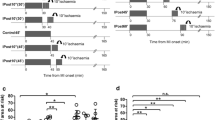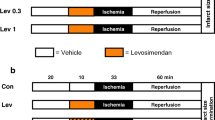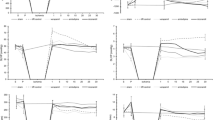Abstract
Ischemic cell injury and the uptake mechanism of99mTc-PYP (Pyrophosphate) were studied with preconditioning and calcium antagonist. Method: The coronary artery of an adult mongrel dog was clamped for 1 hour, followed by reperfusion and99mTc-PYP injection. A control group (group C, n = 8), a group in which continuous drip infusion of diltiazem (10 mg/kg) (group D, n = 7), and a group preconditioned by six 5-minute clampings and perfusions before occlusion (group P, n = 6) were compared. Results: Wall motion was fully recovered in group D but not in group P after 2 hours of reperfusion. The99mTc-PYP uptake ratio showed a significant (p < 0.05) reduction in group D (11.5: 3.6 compared with group C), but not in group P (11.5: 9.1, p = 0.25). The infarct area was 1.2 ± 0.6% of the left ventricle in group D, 1.3 ± 0.4 in group P, and 6.4 ± 1.0 in group C (p < 0.01 in groups D and P vs. group C). Conclusions: These findings suggest that preconditioning does not alleviate stunning, but it improves cell injury in spite of high uptake of99mTc-PYP. Diltiazem protects from both stunning and cell injury, suggesting a different mechanism of myocardial protection from that of preconditioning.
Similar content being viewed by others
References
Henrichs KJ, Matsuoka H, Schaper J. Influence of repetitive coronary occlusion on myocardial adenine nucleosides, high energy phosphate and ultrastructure.Basic Res Cardiol 82: 557–565, 1987.
Hori M, Kitakaze M, Sato H, Takashima S, Iwakura K, Inoue M, et al. Staged reperfusion attenuates myocardial stunning in dogs; Role of transient acidosis during early reperfusion.Circulation 84: 2135–2145, 1991.
Mehta PM, Przyklenk K, Kloner A. Cardioprotective effects of captopril in myocardial ischaemia, ischaemia/ reperfusion and infarction.Eur Heart J 11 (Suppl B): 94–99, 1990.
Higginson L, Tang A, Knoll G, Calvin J. Effect of intracoronary diltiazem on infarct size and regional myocardial function in the ischemic reperfused canine heart.J Am Coll Cardiol 18: 868–875, 1991.
Murry CE, Richard VJ, Jennings RB, Reimer KA. Myocardial protection is lost before contractile function recovers from ischemic preconditioning.Am J Physiol (Heart Circ Physiol) 260: H796-H804, 1991.
Omar BA, Hanson AK, Bose SK, McCord JM. Reperfusion with pyruvate eliminates ischemic preconditioning in the isolated rabbit heart: an apparent role for enhanced glycolysis.Coron Artery Dis 2: 799–804, 1991.
Iwamoto T, Miura T, Adachi T, Noto T, Ogawa T, Tsuchida A, et al. Myocardial infarct size-limiting effect of ischemic preconditioning was not attenuated by oxygen free-radical scavengers in the rabbit.Circulation 83: 1015–1022, 1991.
Nohara R, Kambara H, Okuda K, Ono S, Tamaki N, Konishi J, et al. Effect of diltiazem on stunned myocardium evaluated with99mTc-pyrophosphate imaging in canine heart.Jpn Circ J 56 (3): 262–271, 1992.
Okuda K, Nohara R, Fujita M, Tamaki N, Konishi J, Sasayama S. Technetium-99m-pyrophosphate uptake as an indicator of myocardial injury without infarct.J Nucl Med 35: 1366–1370, 1994.
Bask WL, Reimer KA, Jenning RB. Effect of repetitive brief episodes of ischemia on cell volume, electrolytes and ultrastructure.JACC 8: 33A-41A, 1986.
Li GC, Vasquez JA, Gallagher KP, Lucchesi BR. Myocardial protection with preconditioning.Circulation 82: 609–619, 1990.
Roman S, Scott R, Harting J, Schaper W. Ischemic preconditioning is not a function of stunned myocardium.J Mol Cell 23 (Suppl V): P43, 1991.
Ovize M, Przyklenk K, Hale SL, Kloner RA. Preconditioning does not attenuate myocardial stunning.Circulation 85: 2247–2254, 1992.
Ovize M, Kloner RA, Hale SL, Przyklenk K. Coronary cyclic flow variations “Precondition” ischemic myocardium.Circulation 85: 779–789, 1992.
Heydrickx GR, Millard RW, Mcritchie RJ, Maroko PR, Vatner SF. Regional myocardial function and electrophysiological alterations after brief coronary artery occlusion in conscious dogs.J Clin Invest 56: 978–985, 1975.
Murry CE, Jennings RB, Reimer Keith AR. Precondition- ing with ischemia: a delay of lethal cell injury in ischemic myocardium.Circulation 74: 1124–1136, 1986.
Murry CE, Richard VJ, Reimer KA, Jenning RB. Ischemic preconditioning slows energy metabolism and delays ultrastructual damage during a sustained ischemic episode.Circ Res 66: 913–931, 1990.
Swain JL, Sabina RL, Hines JJ, Greenfield Jr JC, Holmes EW. Repetitive episode of brief ischemia (12 min) do not produce a cumulative depletion of high energy phosphate compounds.Cardiovasc Res 18: 264–269, 1984.
Reimer KA, Murry CE, Yamasawa I, Hill ML, Jenning RB. Four brief periods of myocardial ischemia cause no cumu- lative ATP loss or necrosis.Am J Physiol 251: H1306-H1315, 1986.
Armeiger LC, Seelye RN, Elswijk JG, Carnell VM, Benson DC, Gavin JB. Mitochondrial changes in dog myocardium induced by lactatein vivo.Lab Invest 33–5: 502–509, 1975.
Nicklas JM, Becker LC, Bulkley BH. Effects of repeated brief coronary occlusion on regional left ventricular function and dimension in dogs.Am J Cardiol 56: 473–478, 1985.
Neely JR, Grotyohann LW. Role of glycolytic in damage to ischemic myocardium.Circ Res 55: 816–824, 1984.
Fleet WF, Johnson TA, Graebner CA, Gettes LS. Effect of serial brief ischemic episode on extracellular K+, pH, and activation in the pig.Circulation 72-4: 922–932, 1985.
Cohen MV, Liu GS, Downey JM. Preconditioning causes improved wall motion as well as smaller infarcts after transient coronary occlusion in rabbits.Circulation 84: 341–349, 1991.
Willerson JT, Parkey RW, Bonte FJ, Meyer SL, Atkins JM, Stokely EM. Technetium stannous pyrophosphate myocardial scintigrams in patients with chest pain of varing etiology.Circulation 51: 1046–1052, 1975.
Abdulla AM, Canedo M, Cortez BC, McGinnis KD, Wilhelm SK. Detection of unstable angina by99mTechnetium Pyrophosphate myocardial scintigraphy.Chest 69-2: 168–173, 1976.
Lessen J, Johansson BW, Nosslin B, Thorell J. Myocardial scintigraphy with99mTc-pyrophosphate in patients with unstable angina pectoris.Acta Med Scand 203: 491–495, 1978.
Homer WH, Alonso DR, Jacobstein JG. Ischemia and infarction in the isolated rabbit heart: A model for the evaluation of myocardial imaging agents.J Nucl Med 21: 523–528, 1980.
Bianco JA, Kemper AJ, Taylor A, Lazewatsky J, Tow DE, Khuri SF. Technetium-99m(Sn2+)pyrophosphate in ischemic and infarcted dog myocardium in early stage of acute coronary occlusion: Histochemical and tissue-counting comparisons.J Nucl Med 24: 485–491, 1983.
Hashimoto T, Kamabara H, Fudo T, Tamaki N, Konishi J, Kawai C, et al. Significance of Technetium-99m/Thallium- 201 overlap on simultaneous dual emission computed tomography in acute myocardial infarction.Am J Cardiol 24: 485–490, 1988.
Reimer KA, Jenning RB. Verapamil in two reperfusion models of myocardial infarction.Lab Invest 51-6: 655–665, 1984.
Liu GS, Thornton BS, Winkle DMV, Starley AW, Olsson RA, Donney JM. Prefusion against infarction afforded by preconditioning is mediated by A1 adenosine receptor in rabbit heart.Circulation 84: 350–356, 1991.
Gross GJ, Auchampach JA. Blockade of ATP-sensitive potassium channels prevents myocardial preconditioning in dogs.Circ Res 70: 223–233, 1992.
Miyamae M, Fujiwara H, Kida M, Yokota R, Tanaka M, Katsuragawa M, et al. Preconditioning improves energy metabolism during reperfusion but does not attenuate myocardial stunning in porcine hearts.Circulation 88: 223–234, 1993.
Ovize M, Przyklenk K, Hale S, Klouer RA. Preconditioning does not attenuate myocardial stunning.Circulation 85: 2247–2254, 1992.
Author information
Authors and Affiliations
Rights and permissions
About this article
Cite this article
Okuda, K., Nohara, R., Ogino, M. et al. Limitation of infarct size with preconditioning and calcium antagonist (Diltiazem): Difference in99mTc-PYP uptake in the myocardium. Ann Nucl Med 10, 201–209 (1996). https://doi.org/10.1007/BF03165393
Received:
Accepted:
Issue Date:
DOI: https://doi.org/10.1007/BF03165393




